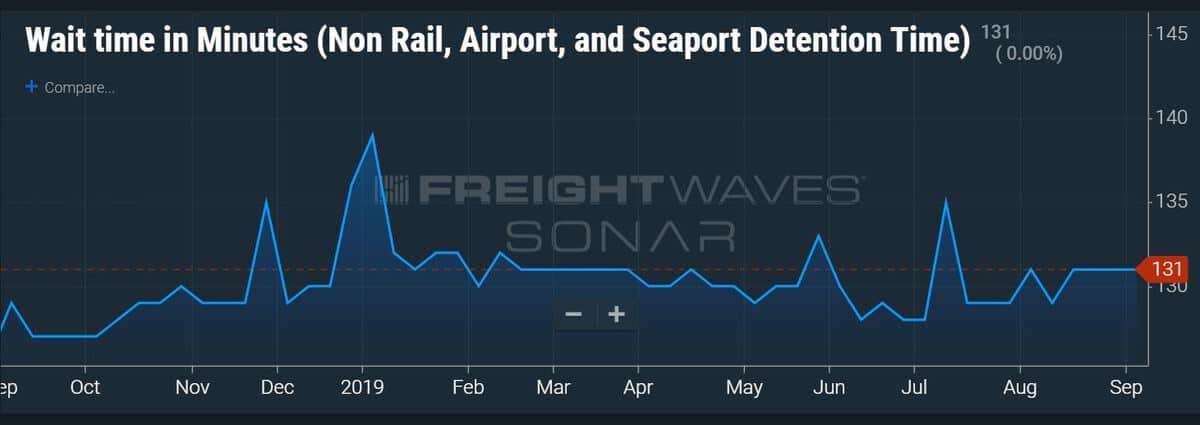Longer waits to load and unload freight continue to vex truckers, especially women drivers less likely to complain about being kept waiting, according to new survey data from the American Transportation Research Institute.
Both the length and frequency of detention — the number of average minutes a truck spends inside a shipper or receiver location for unloading and loading — have increased over the last four years, ATRI reported Sept. 4. The analysis was based on more than 1,900 driver and motor carrier surveys conducted in 2014 and 2018.
Delays of two or more hours increased 11.2% between 2014 and 2018, with delays of six or more hours rising 27.4%.
Nearly 40% of drivers who completed surveys at major trucking shows in Louisville, KY, and Dallas in 2018 reported that seven of 10 of their pickups and deliveries were delayed by customer actions over the past 12 months.
FreightWaves SONAR data (WAIT.TRUCK) shows trucking wait times averaging 131 minutes – just over two hours — nationally so far in September.

Women drivers wait longer
Women were disproportionately impacted, according to ATRI, the research arm of the American Trucking Associations (ATA).
Women were 83.3% more likely than men to be delayed six or more hours. ATRI said that had less to do with discrimination than with women driving refrigerated trucks, which were hung up longer in queue than drivers of dry vans or flatbeds.
Another factor is that women are less likely to complain about longer waits than men.
“I think it’s possible the people at shippers and receivers are yelled at more by men than by women,” one female driver responded in a survey.
“I am less likely to go in and start drama and throw a fit because I’m not empty yet, as opposed to the guy next to me,” another female driver wrote. “A lot of my male driving friends become aggravated more quickly.”
A third female driver said she doubts discrimination is a factor.
“When we back into a dock, the guys working don’t know what gender is driving the truck, nor do they care,” she said.
Refrigerated delays
Both drivers and carriers told ATRI that refrigerated trailers and bulk/food haulers spent the most time in detention, typically much longer than the two hours considered acceptable.
“Occasionally, I will look for filler loads, but when I do I never consider hauling anything grocery-related because the wait time could be eight hours or more,” one driver wrote, adding that he is likely to lose money if detention time isn’t paid.
HOS challenges
Customer detention times impact productivity and eat into the maximum 11 hours behind the wheel a driver is allowed to operate within a 14-hour period under federal hours-of-service (HOS) rules.
The December 2017 electronic logging device (ELD) mandate led to more carriers charging from $50 to $100 an hour for detention time. But the average hourly charge of $63.71 was below the $66.65 average truck’s hourly operating expense, which includes 43% for driver pay and benefits.
Most drivers received 40% or more of the detention pay. But 20% of smaller carriers said they don’t charge for excessive delays so they can get more loads. That undercuts big carriers that do charge, ATRI said.
The ELD digital countdown clock caused nearly eight of 10 drivers to run out of driving time while detained at a customer facility, but fewer than two in 10 used the ELD data to show how long they were being delayed.
Nearly 70% percent of carriers and 78% of drivers indicated that customer delays had a moderate or significant impact on their weekly revenue because of missed delivery times at the next customer.
Shippers and receivers may not care about HOS constraints on the driver, may not understand the HOS regulations and are not held accountable for excessive delays — all of which aggravates the impact of detention on safety and productivity, carriers and drivers said.
“ATRI’s new detention research definitely helps us understand the full financial impact associated with detaining drivers,” said Edgar R. McGonigal, chief financial officer of Bestway Express Inc. “From a safety and economic perspective, this research gives the trucking industry new insight into how both carriers and drivers should implement driver detention strategies.”
